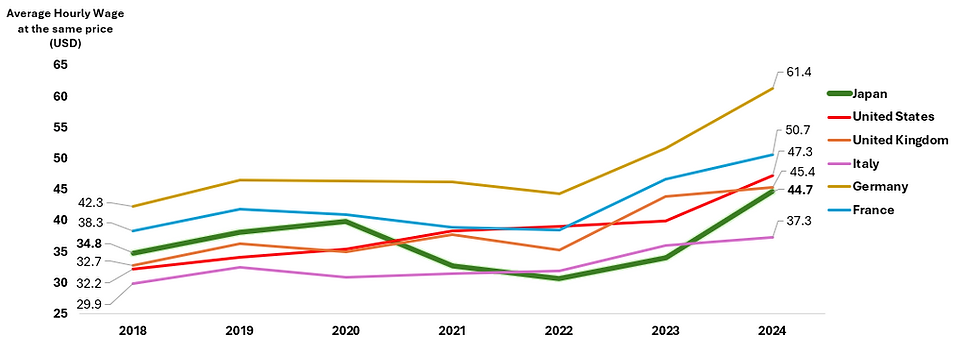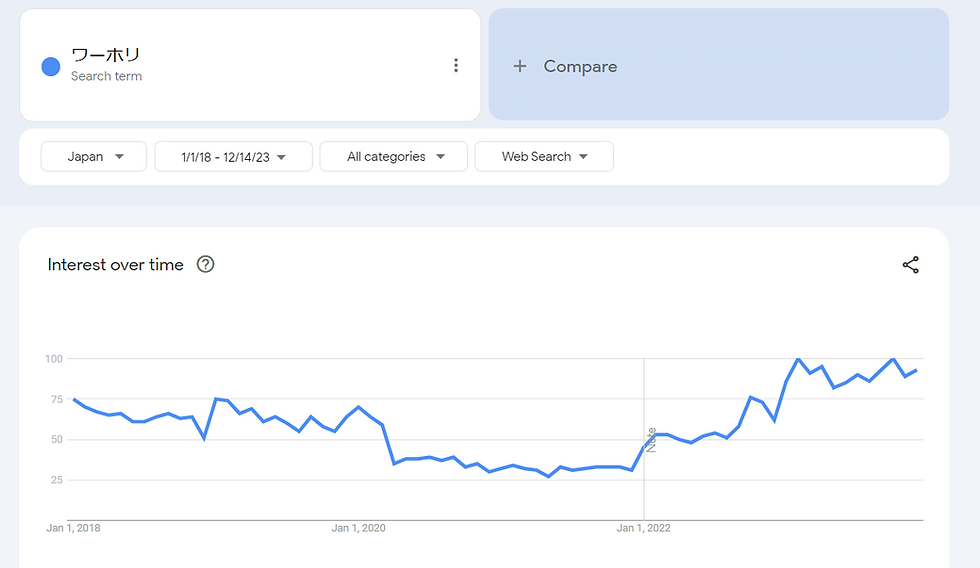Is the Claim 'Salaries in Japan are Low' True?
- Daichi Mitsuzawa
- Dec 15, 2023
- 6 min read
Updated: May 8
1. Introduction
A simple search for "Salary in Japan" often yields phrases like "salaries in Japan are too low," "low wages in Japan," and "Japanese salaries not rising." Indeed, according to the Monthly Labor Statistics Survey published by the Ministry of Health, Labour and Welfare in October 2023, Japan's real wages decreased by 2.3% compared to the previous year, marking the 19th consecutive month of decline*1. In a global comparison, Japan's annual average wages in 2022 were lower than the OECD average, ranking 25th, just above Spain*2. These figures are adjusted for Purchasing Power Parity (PPP) and, although in USD, take into account cost of living adjustments.
Figure 1: Average wages (Wage)
Under such wage conditions, there is a growing interest in salaries in Japan (see Figure 2*3).
Recently, the concept of "Working Holiday" has become popular among Japanese, characterized by long-term stays abroad primarily for work. Google Trends shows an uptrend in searches for "Working Holiday" post-COVID (see Figure 3*4). Notably, in 2023, the number of working holiday visas issued to Japanese nationals in Australia hit a record high*5. With the current weak yen, converting earnings from working holidays into yen can result in significantly higher savings than working part-time in Japan.
Figure 2: Google Trend 「日本 給料 (which means "Japan Salary")」
Figure 3: Google Trend 「ワーホリ(which is an abbreviation of working holiday)」
Indeed, Japan's wages are low according to OECD data.
However, Japanese individuals who frequently travel abroad or have many friends in Western Countries might wonder why wages, when adjusted for Purchasing Power Parity (PPP), are higher there, despite the notable challenges posed by higher living costs in many Western countries.
In fact, even employees at top Western companies often have to limit their spending drastically, such as rarely dining out, commuting by bike or walking due to high public transport costs, sharing flats with others, etc.
To address this question, our company conducted its own survey and analysis to determine whether Japan's wage levels relative to domestic prices are genuinely lower compared to other countries.
2. Basic Methodology*a
First, it's important to note that the aforementioned OECD average annual wage data, often quoted by global media, has some unclear aspects in its PPP adjustment logic. Even when the Ministry of Health, Labour and Welfare cited this data, they mentioned these ambiguities*6.
Furthermore, the usefulness of average annual wages in addressing our question is doubtful. Annual average wages can be broken down into hourly wage and working hours. However, working hours as a variable can introduce noise in measuring "wages relative to domestic prices."*b Therefore, we focused on hourly wages, using pre-PPP-adjusted data to calculate hourly wages in different countries and dividing them by the respective country's price index relative to New York*c. This method also mitigates the impact of exchange rate fluctuations.
For comparison, we chose G7 countries (excluding Canada) often used as benchmarks in various media.
Lastly, we used the average price index of the top three cities in each country from Numbeo's "Cost of Living Plus Rent Index by City 2023." If a country didn't have data for three cities, we used the average of the available cities. This approach allowed us to compare prices in cities with more full-time job options and to calculate values closer to our study's objective.
3. Survey Results
Figure 4: Average Nominal Hourly Wage at Comparable Price Levels (2018-2024) *Updated: May 8th, 2025

In 2024, Japan's average nominal hourly wage at comparable price levels ranked 5th among the G7 countries (excluding Canada), following the United Kingdom (USD 45.4) and ahead of Italy (USD 37.3). Germany topped the list at USD 61.4, indicating Japan's competitiveness in G7 wage rankings. Over the past five years, Japan's position fluctuated, closely trailing France in 2020, and currently stabilizing at 5th since 2023. Germany has consistently held the top position.
4. Insights
In conclusion, Japan's wages relative to domestic prices post-COVID are lower compared to other countries, but not exceptionally so.
In fact, the 2018 comparison with the U.S. was +13.7%, and in 2023 it's -13.6%. Back in 2018, the U.S. was in a similar position to Japan today. Yet, there were no significant complaints about low wages in the U.S. compared to domestic prices at that time (see Figure 5). Therefore, it's worth reconsidering the current generalizations about "high wages in the U.S. and low wages in Japan."
Figure 5: Google Trend 「US Salary Low」
Looking ahead, wage increases in Japan are expected to surpass those of 2023 in the 2024 spring wage negotiations*8, and there are forecasts of stable real wage growth in the latter half of 2025*9, highlighting positive future wage trends in Japan.
Furthermore, Japan's average nominal hourly wage at comparable price levels in 2023 increased by 13.1% year-over-year, outperforming the CAGR of +7.3% from 2018-2020, indicating a rapid recovery. Considering this trend and the expected rise in real wages, Japan could climb higher in the G7 rankings.
5. Conclusion of Japan's Salaries
To revisit our initial question: "Are Japan's wages relative to domestic prices lower compared to other countries?"
The answer for 2022 and 2023 might be yes, but not for 2024.
Although Japanese wages have been criticized based on OECD's average wage figures, the situation is improving, and a brighter future is expected. Students concerned about future wages and company officials apprehensive about offering competitive salaries to international talents should feel more optimistic about Japan's prospects.
We hope this report serves as a valuable resource in their decision-making.
(Edit by Jelper Club Team)
This article was created by Jelper Club.
What is Jelper Club? Jelper Club is a platform aiming to connect current students from top universities across the globe with tailored career opportunities in Japan. We bring together students, young professionals, and companies to provide access to exclusive and practical information, opportunities, member-only events, and other benefits.
We welcome ambitious top global talents who are passionate about Japan. Learn more and apply today at info.jelper.co
1. "毎月勤労統計調査" (Ministry of Health, Labour and Welfare):https://www.mhlw.go.jp/toukei/list/30-1.html 2."平均賃金(Average wage)" (OECD):https://www.oecd.org/tokyo/statistics/average-wages-japanese-version.htm 3・4・7. "Google Trend"(Google):https://trends.google.com/trends/
5. "Why Japan’s young are working in Australia in record numbers" (The Australian Financial Review): https://www.afr.com/world/asia/why-japan-s-young-are-working-in-australia-in-record-numbers-20231130-p5eo0w
6. "Wage Trends in G7 Countries" (Nominal and Real) (Ministry of Health, Labour and Welfare):https://www.mhlw.go.jp/stf/wp/hakusyo/roudou/21/backdata/column01-03-1.html
8. "春闘2024要求は? 賃上げ5%以上 定期昇給分含む 連合が方針固める"(NHK):https://www.nhk.or.jp/shutoken/newsup/20231018b.html
9. "2024年の物価・賃金、金融政策展望(10月CPI)"(NRI):https://www.nri.com/jp/knowledge/blog/lst/2023/fis/kiuchi/1124
a. Calculation Logic
・The price level is benchmarked to the cost of living in New York; the index represents the US dollar value of each country’s consumer goods plus rent compared to New York.
・The average hourly wage adjusted for price index is calculated as follows:① Number of full-time employees × ② Average annual nominal wage (full-time) ÷ ③ Total annual working hours ÷ ④ Price index × 100.③ is calculated by multiplying weekly working hours by the average number of working weeks per year (= Total weeks in a year – (Number of public holidays + Average paid leave days) ÷ 7). Since OECD only publishes weekly working hours, 52 weeks are used for most years (53 weeks used for 2020).For Japan, the total annual working hours are derived from the sum of average monthly working hours for full-time workers as published in the Monthly Labour Survey. For countries other than the U.S., the average number of paid leave days is based on 2022 data from the Databook of International Labour Statistics 2024 (2020 for the UK); for the U.S., data is from Sorbet’s 2023 report.Figures for ①, ②, and ③ from 2018–2023 are actual data; the 2024 values are estimates calculated by applying the sixth root of the ratio between 2017 and 2023 values to the 2023 figure as the annual average growth rate.For each country, ④ (price index) is the average of the indices for the top three cities listed on Numbeo. If fewer than three cities are available, the average of available cities is used.
※Source:
・Average annual wages (indicator) (OECD)
・Average usual weekly hours worked on the main job (OECD)
・FTPT employment based on national definitions (OECD)
・Cost of Living Plus Rent Index by City 2023 (Numbeo)
・毎月勤労統計調査(厚生労働省)
・Sorbet PTO Report 2024 (Sorbet)
・Exchange Rate Archives by Month (IMF)
b. As an independent variable, working hours include not only government regulations and corporate-imposed hours but also personal choice, making it logically inappropriate for calculating the answer to this question.
c. To calculate the index against New York's prices, hourly wage values are used to avoid making price a duplicate variable.









Comments